For most, the word “piracy” brings to mind illegally acquired movies, music, games, and more, usually found through purpose-made pirate sites and services.
However, far fewer are aware that mobile apps are also a prominent target for pirates.
Mobile app piracy is rife across the globe, and affects all mobile platforms.
Additionally, as pirates often strip out analytics when they hijack an app and redistribute it under their own name, nobody really knows exactly how much of a problem it is – everyone from app developers to attribution companies ends up being left in the dark.
Despite this, there is little data – and hardly any effective tools – for dealing with app piracy. As such, many are still unaware of just how big an impact piracy has on the mobile app industry as a whole.
What is mobile app piracy?
When it comes to mobile apps, piracy refers to the illegal modification and/or distribution of an app by someone other than its official owner. Pirates have many ways of profiting from stolen apps, with some of them much harder to detect and deal with than others.
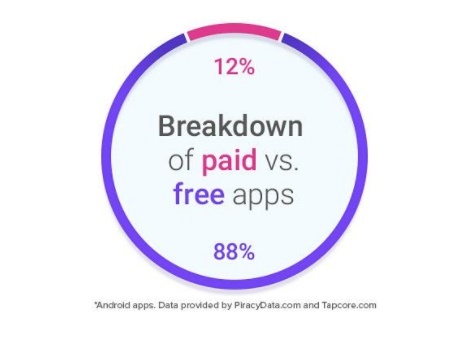
Pirates strip out SDKs as they please, thereby removing attribution, advertising, and tracking functionalities. The latter in particular means that developers may never even realise their app has been stolen. Once comprised, the pirates can then republish the apps on one of the many alternative app stores around the world with their own monetization solutions included, thereby routing all profits to themselves rather than the rightful owner.
This has led the mobile app industry to move towards a freemium business model, focusing on apps that are free to download but monetized via other methods such as in-app purchases or advertising. This shift, however, hasn’t deterred pirates from continuing their practices, as even freemium apps are subject to rampant piracy.
Through data compiled by piracy tracking tool PiracyData on apps from the Western market, we can begin to understand the full scope of the problem.
So who’s losing out when it comes to piracy?
It’s paid apps that most people think of when it comes to mobile piracy, and below are the top ten premium apps that are being hit hardest by pirates.
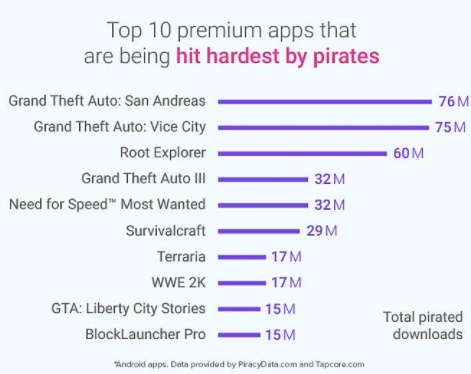
However, freemium apps are also high-priority targets for piracy and tampering – indeed, their numbers easily exceed those of the premium top ten.
It is estimated that around $14 billion in revenue is lost globally to mobile app piracy each year, due to both illegally downloaded premium apps and freemium apps whose monetization has been removed.
What sort of apps get pirated?
It’s a common misconception that games are the only type of apps targeted by pirates.
Indeed, out of the top 100 most pirated apps, 28 – less than a third – are game apps. The rest cover anything from lifestyle apps, to utilities and a wide variety of others
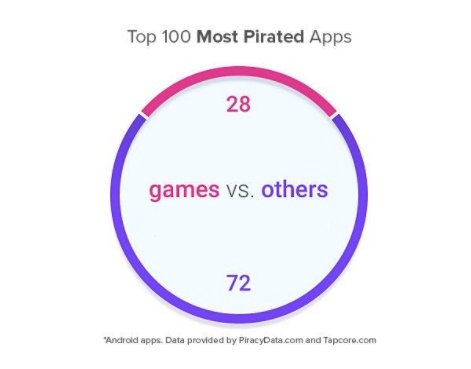
While this figure does increase when it comes to paid apps (where 79 of the 100 apps are games), it still makes an important point: it’s not only game developers that find themselves falling foul of piracy.
The below have the dubious honor of being the top ten most pirated game apps:
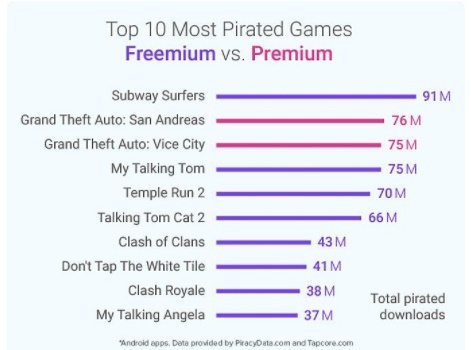
Premium versus freemium
While as many as 95% of all premium app installs are pirated, freemium apps are not exempt from the piracy problem, with an estimated 7.5% to 15% of all freemium apps installs pirated.
A staggering 92 of the top 100 most pirated apps are freemium.
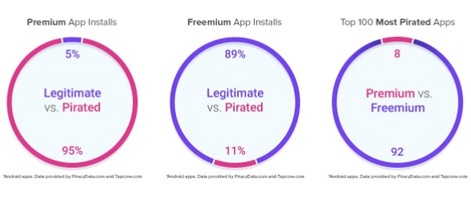
Piracy of ostensibly free apps can occur for a number of reasons, including:
- To modify the way a game or app works
- To bypass in-app purchases
- To cut out advertising
- To gain access to app in a region where it is not officially distributed
Out of the 28 games that feature in the top 100 most pirated apps, 75% of them are free to play, as well as 10% of the games featured in the biggest revenue loss list. 42 of the top 100 most pirated games are free to play – and 8 of the top ten.
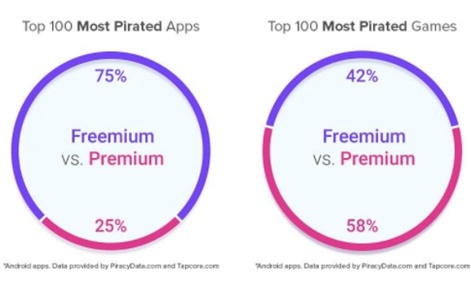
Alternative app stores and piracy
While there are a number of legitimate third-party app stores that offer developers great opportunities when it comes to releasing their apps, they are also playgrounds for piracy.
Most third-party app stores are much less strictly regulated than the likes of the Apple App Store and Google Play, meaning it’s far easier for pirates to get away with redistributing stolen apps and monetizing them.
Additionally, in some countries the use of Google and its services are restricted and even banned completely. This means that some users turn to pirated downloads when they are unable to get hold of big-name apps by legitimate means, resulting in a profit for opportunistic pirates.
Installing apps from alternative app stores also requires users to enable downloads from unknown sources, which can put them at risk of viruses and malware – something many pirates will be only too keen to exploit for their own malicious purposes.
Together with Google Play, alternative Android app stores will soon overtake the Apple App Store as the most lucrative, with an article by Tapcore citing predictions that their combined downloads will reach 299 billion in 2021.
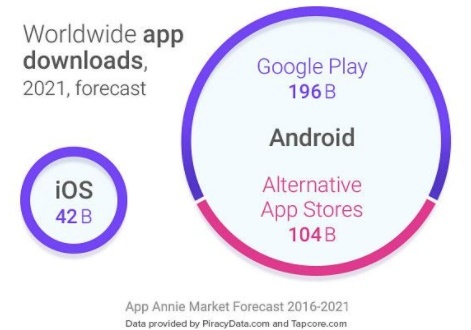
Revenue from iOS apps is set to hit $60 billion by 2021. However, this is nothing compared with Google Play’s $42 billion and the additional $36 billion predicted for alternative app stores. Together, they are set to generate almost $80 billion between them – 30% more than Apple.
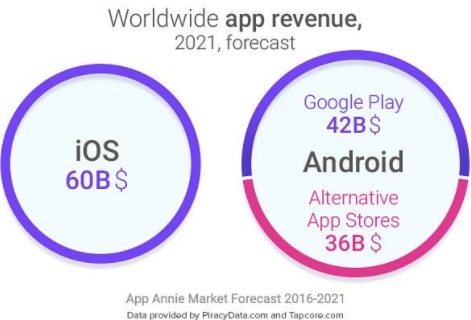
So how can you face the piracy problem?
Although you can never really escape piracy, you can take measures to combat it.
One of the best ways to do so is to make sure you’re as informed as possible by:
- Taking advantage of resources like PiracyData, which provides key data about mobile app piracy as a whole as well as on an app-by-app basis
- Analyzing as many metrics as possible to identify any changes in patterns or other activity that could be indicative of piracy
- Making sure you’re aware of the many ways in which your app can be pirated (and, where possible, how to prevent them with anti-piracy tools)
Fortunately, there's an increasing emergence of resources to aid in discovering more about how apps are pirated, the extent to which they're being targeted, and also tools to help you tackle the issue head on.
A prime example is Tapcore, a platform created to help developers identify, track and monetize illegal/pirated versions of their app.
By understanding the scope of the piracy problem and how it can best be addressed, you can take the power away from the pirates and regain control of your business.























